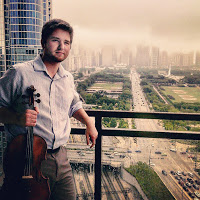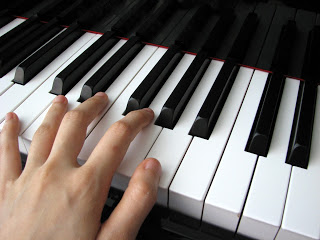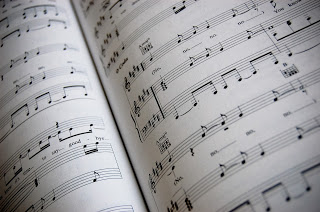The creative process is a tricky beast to tame. A lot of the time, it seems as if
creativity is intangible and difficult to even conceptualize. Bursts of
inspiration strike at random and sometimes inconvenient times. Here is a
question I have asked myself many times: why are there days when I can sit down
and write quality music and the next day not a single good idea comes to mind?
While there isn’t a single, ubiquitous answer, I can offer you some advice from
my own experiences on how I have made the creative process less elusive and something
I can use as a tool to optimize my compositional output.
towards music composition, but many of the concepts can be applied to any sort
of creative endeavor.
1. Know What Works for You
your own personal strengths and weaknesses is the number one piece of advice I
could give any composer. For starters, people have different peaks of
creativity throughout the day. I usually experience the best creative
concentrations in the early afternoon and between midnight and 2:00am. If you
are a morning person, maybe you like to sit down with a cup of coffee at 6:00am
and start putting notes on the page. Every person is slightly different in this
regard, so try different things and figure out what works for you.
writing music in different ways. If you have never written notation by hand
with a pencil and paper, try that for a change. If you have never used a
digital audio workstation, try using one. There are a lot of tools out there to
use, and knowing which ones you are most compatible with is the first and
easiest step to success.
2. Create a Schedule
Knowing what kind of time structure gels best with your creativity is sure to give a
boost to your productivity. I have encountered two main camps of composers with
this regard: some compose in short (less than one hour) sessions throughout the
day while others compose in large (1.5+ hours), pre-determined blocks of time. Experiment
with these as you are able to and figure out what works for you. Here are some
advantages and disadvantages I have found in each:
- Pros of working in short time blocks:
Smaller goals are more easily attained. If you have 20 minutes to write music,
you could make your goal to write two or three measures. Then when you achieve
that small goal, the feeling of accomplishment and motivation carries you into
the next session.
- Cons of working in small time blocks: It
might be difficult to quickly shift in and out of a composing mindset throughout
the day. If shifting gears quickly is not your thing, this option might not be
for you.
- Pros of working in long time blocks:
Getting a lot done all at once. With this method you can sit down and write a
substantial amount of work, all within the same train of thought. Ideas have
room to breathe and be experimented with. If use this method, make sure to set
goals for each session that are realistic. It can be more difficult to
anticipate what you are actually capable of accomplishing over a longer period
of time.
- Cons of working in long time blocks:
Burning out and losing focus. If it is difficult for you to focus on a detailed
project for a long period of time without losing focus or becoming frustrated,
working in long time blocks might not be for you.
like to plan out my week hour by hour to make sure everything important gets
accomplished. I try to work the rest of my schedule around the composing times
that I know work best for my creativity. Usually my blocks for composing are
2-3 hours and I have at least one per day. Some weeks I will get lucky and have
a totally empty Saturday that I can fill with an eight hour composition binge (often
followed by an eight hour Netflix binge).
isn’t a right or wrong when it comes to scheduling your composition time as
long as it is productive, consistent, and works for you. In fact, sometimes I use
a mix of the two methods depending on what my schedule looks like on a
particular day. Having a regular routine is the important part – you can’t just wait for inspiration to
strike. If you have found that what you are currently doing isn’t working
very well, change it up and try the other way.
3. Structure Your Composing Time
you are entering MIDI sequences into the DAW of your choice, notating music
into an engraving program like Finale or Sibelius, or even handwriting sheet
music, structuring your composition time with goals is another way to optimize
your creativity for maximum production. The famous Russian composer Pyotr
Tchaikovsky is one of my favorite models of this. Every day he followed this
schedule:
Wake up, read/study, drink tea
Go for a walk to gather inspiration / take notes of compositional ideas
Compose sketches at the piano
Lunch
Go for another walk
Afternoon tea, read the paper, meet visitors
Compose and orchestrate the sketches from the morning
Walk, play piano, supper, write letters, play cards
Bedtime
Take
note of how he used his two blocks of composing time during the day: in the
morning session he would write sketches at the piano; in his evening session he
would orchestrate these sketches. It’s a very simple structure and while I’m
sure that he probably had more specific daily goals, incorporating a broad
system of goals like this into your routine will give you a place to start. He
didn’t just sit down with a blank sheet of paper in front of him and wait for
the ideas to emerge. If you don’t already, I would highly recommend writing out
a detailed schedule like this. Set goals in your schedule. For example, write “on
Monday from 10:00-12:00 I will write 20 measures of music for [name] project.”
4. Secure the Fundamentals
that we have talked about when you
will be composing, let’s dig into the how.
Creativity in itself is nothing without some basic tools for effective
execution. Even when you are inspired and you feel on the precipice of a masterpiece,
you must first decide on some fundamentals of the music.
This will depend on what the nature of the project is. If you are writing a
sentimental film cue, maybe you just want some delicate solo piano playing. If
you are writing a chiptune for a video game, knowing what synthesized sounds you
will be working with should be one of the first things you do to get the
project rolling. Immersing yourself with other music in the genre you are
writing will give you a good sense of what an appropriate instrumentation is. It
might be that you are working on music for a film or video game project, in
which case some parameters might be predetermined by a director, but if you
have free reign over this aspect of the music, make deliberate and informed
choices. Instrumentation might also be determined by what resources you have
access to. If you have limited resources, don’t be afraid to get creative. An
entire film score could be written with a piano or a string quartet on a budget
and still be very effective.
Key center:
There are 11 standardized major and minor keys, as well as seven modes for each
of those key centers. So how do you know which key to use? Does the music
modulate at any point and why? These are good questions to answer before starting
a project. Knowing what you want your harmonic language to feel like is a good
way to start getting that great idea from your head into real music that other
people can enjoy. Here’s what not to do: pick your favorite key and write the
music in that key. Every key has slightly different colors and connotations.
Familiarize yourself with what keys other pieces of the same style are written
in, because people hearing your music will create associations with existing
music. For example, if you are writing a cue for a game that takes place in the
medieval era, you might write in a Dorian mode. If you are writing something
uplifting and positive you will probably want to write in a major key (Ionian).
If you are already a very experienced composer, or you are just a theory buff,
you might also take into consideration when using atonality, bitonality, micro-tonality,
non-pitched materials, and other 20th century ideas about harmony
and extended techniques are appropriate. These concepts can create very
distinct and effective sounds for the stage and for multimedia collaborations. Here
are a few considerations for picking which key center to use:
Instrumentation:
If you are working with live instruments, pick a key that works with your melodic
and harmonic content to create the most idiomatic music for these instruments.
Difficulty
of the key for performance: Accomplished musicians will be
able to perform in any key, but there are tonalities that resonate better with certain
instruments. For example, the keys of C, G, D, and A are really good for string
instruments because of the strong sympathetic vibrations that the instruments
produce on their open strings.
Range
of the music: If the music goes too high or too low
in a certain key, consider moving it chromatically to accommodate the range.
While you might not discover this is the case until you start sketching melodic
and harmonic ideas, it is good to keep in mind early on. This is especially pertinent
when writing music for acoustic instruments. Typically, you will want to
maximize an instruments full range potential. This means structuring the piece
in a way that both the lowest range and highest range are taken advantage of. Using
a key center that effectively accommodates your use of the instrument’s range
is a staple of idiomatic instrumental writing.
Historic
connotations: If you are writing a piece that is
supposed to sound inspired by a particular piece or composer, consider using
the same key center that they used in a related work. For example, if you are
writing a piece that is supposed to mimic the drama of Beethoven’s Fifth
Symphony, consider writing your piece in C minor.
Style
(or genre): Putting yourself in the shoes of your
listeners and figuring out what style of music creates the right mood to
achieve your artistic goals is a key item to not just identify, but to fully conceptualize
before you begin to write. The style is created by carefully combining
instrumentation, orchestration, harmonic language, texture, timbre,
articulation, and dynamics. Each of these elements is vastly complex, and the
ways in which they can be combined are infinite.
that we have a solid foundation for setting a schedule and securing the basics
of your composition, there is music to be made! In part two of this article, I
will further discuss how to optimize your creative process. The topics covered
will include strategies for an effective pre-compositional process, and how to
overcome writer’s block as a composer.
next time, happy composing!
 About the Author:
About the Author:Lukas Stanley is a composer, violist, and music educator in Michigan. As an
active composer since 2006, his works are written primarily for local concert
performances. However, he is also passionate about creating new music for film,
video games, and other collaborative projects. To find out more or to contact
Lukas, visit his website at www.lukasstanley.com








